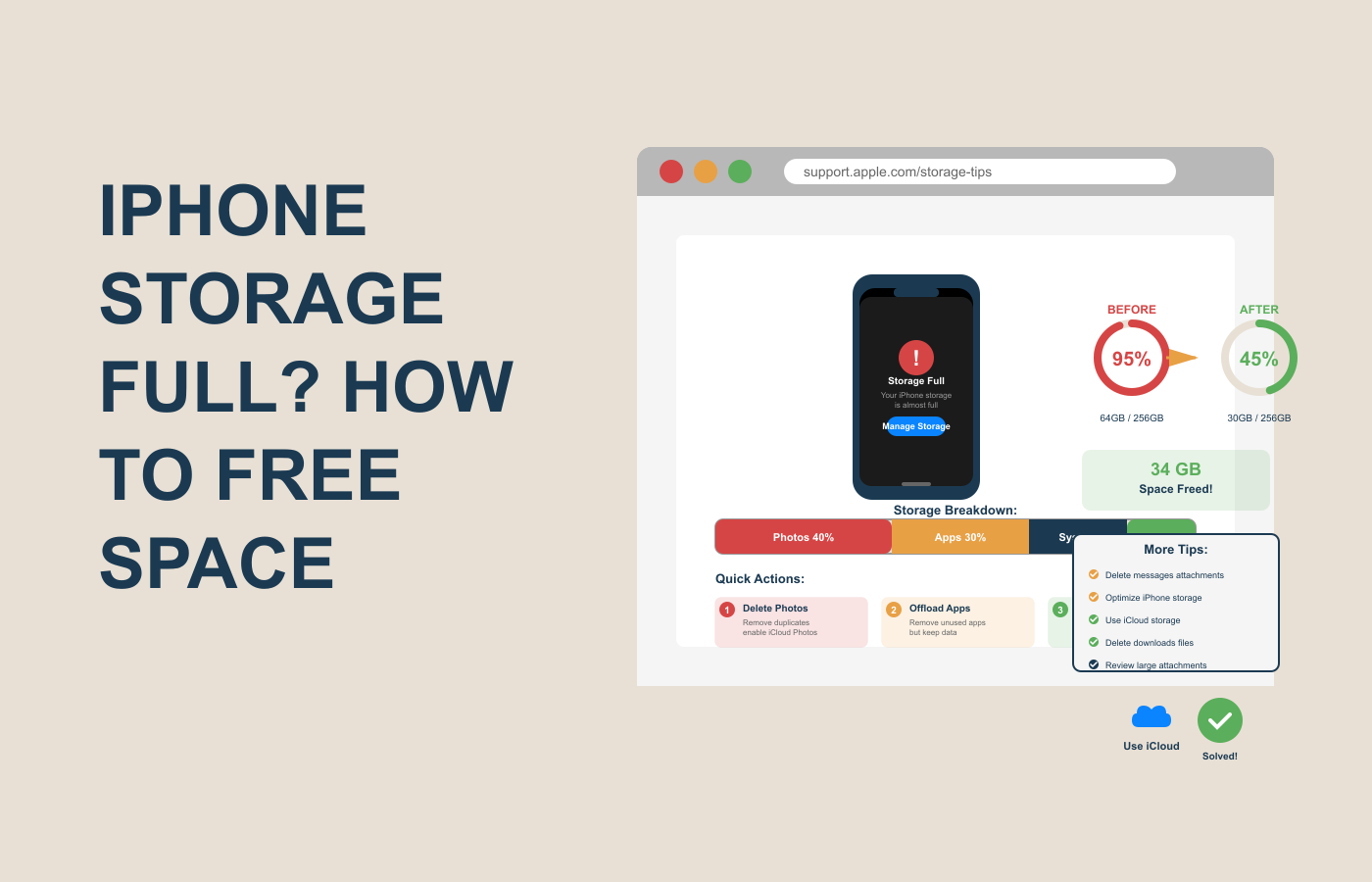iPhone Storage Full? How to Free Space

Why iPhone Storage Gets Full So Quickly
You’re about to take the perfect photo — but suddenly, your iPhone flashes that dreaded message:
“iPhone Storage Full. You can’t take photos.”
Sound familiar?
This is one of the most common frustrations iPhone users face today. Whether you have 64GB or even 256GB of storage, it somehow always fills up faster than you expect.
But here’s the thing — your iPhone isn’t just storing photos and apps. It’s quietly saving cached data, system files, old messages, and backups that slowly eat away your free space over time.
The good news?
You don’t need to delete everything you love just to make room. In this guide, we’ll show you how to free up storage safely without losing your memories or important data.
By the end of this blog, you’ll know why storage fills up, how to fix it permanently, and which smart tricks can help your iPhone stay clean and fast — no matter the model you use.
Common Causes of iPhone Storage Getting Full
Before deleting random files, let’s understand why your iPhone storage keeps filling up. Knowing the cause helps you clean it strategically instead of wiping out everything blindly.
Here are the top reasons behind full iPhone storage:
1. Photos and Videos Take Up Most Space
The iPhone’s amazing camera comes at a cost — high-resolution photos and 4K videos can take up gigabytes in no time.
- A single 1-minute 4K video = around 400MB to 500MB.
- 100 Live Photos can consume over 1GB of space.
If you’re someone who never deletes media, this adds up fast.
2. Apps and Their Cached Data
Many apps — like Instagram, YouTube, or WhatsApp — store hidden cache files to load faster.
Over time, this cached data can grow to several gigabytes without you realizing.
For instance:
- WhatsApp stores all your chat backups, photos, and videos inside the app.
- Safari and Chrome keep website caches and history that silently eat storage.
3. Old iMessages, WhatsApp Chats, and Attachments
Text messages and attachments can stay stored for years, including videos, stickers, and photos from group chats.
Apple’s Messages app alone can hold hundreds of MBs just from attachments. If you’ve been using the same iPhone for years, this is a hidden space killer.
4. System and iOS Files
Every iPhone has a hidden section called “System Data” or “Other Storage.”
It contains:
- Logs and updates
- App data and caches
- Temporary files from iOS
This section often balloons in size after updates or heavy app usage.
5. Duplicate Files and Unused Apps
Sometimes you download multiple versions of the same photo, or you have old apps you never open. These stay on your device even if you forget they exist.
6. Downloads and Offline Files
PDFs, downloaded Netflix shows, Apple Music offline songs — these pile up quietly.
If you use your iPhone for work or entertainment, it’s worth checking your “Downloads” folder.
Now that you know the common causes, let’s dive into actionable solutions that actually work.
How to Check iPhone Storage
Before freeing up space, you should know what’s using your storage.
Here’s how you can check:
- Open Settings
- Tap General → iPhone Storage
- Wait a few seconds for iOS to analyze your storage
You’ll see a detailed bar chart showing how much space is taken by Photos, Apps, Media, System Data, Messages, and Other files.
You might even see Apple’s recommendations like:
- Offload Unused Apps
- Review Large Attachments
- Optimize Photos
These are smart, built-in suggestions that can help you clean up quickly.
Step-by-Step Guide: How to Free Space on iPhone
Let’s go step by step and safely clean your iPhone storage without deleting anything important.
1. Optimize iPhone Photos
If photos and videos take most of your storage, this is the best place to start.
Option A: Use iCloud Photos
iCloud Photos automatically uploads your photos and videos to the cloud, freeing up local storage.
Here’s how:
- Go to Settings → Photos
- Turn on iCloud Photos
- Select Optimize iPhone Storage
This stores compressed versions on your iPhone while keeping full-resolution originals in iCloud.
Tip: You get 5GB of free iCloud storage, but you can upgrade affordably to 50GB or 200GB plans.
Option B: Use Google Photos or Drive
If you prefer a non-Apple option, try Google Photos or Google Drive.
They provide large storage space and allow automatic backups of your iPhone photos.
After uploading:
- Delete photos from your iPhone to instantly free up space.
- You can always re-download them anytime.
2. Delete or Offload Unused Apps
iPhones have a feature called Offload Unused Apps, which removes unused apps while keeping your data safe.
When you reinstall, your data is restored automatically.
To enable it:
- Go to Settings → General → iPhone Storage
- Tap Enable Offload Unused Apps
You can also manually check which apps are taking up space. iOS shows a list of all apps sorted by storage size.
3. Clear App Caches and Temporary Files
Apps like Instagram, Safari, and TikTok can store a ton of cached data.
Here’s how to clean it:
- For Safari: Go to Settings → Safari → Clear History and Website Data
- For Spotify, YouTube, etc.: Open app settings and look for “Storage” or “Clear Cache.”
- For WhatsApp:
- Go to Settings → Storage and Data → Manage Storage
- Delete large videos or chat backups.
If you’re comfortable, uninstalling and reinstalling a bloated app can also free up hidden cache space.
4. Remove Old Messages and Attachments
Messages might not look heavy, but old group chats with videos and memes can easily reach several GBs.
To automatically delete old messages:
- Go to Settings → Messages
- Under “Keep Messages,” select 30 Days or 1 Year instead of “Forever”
You can also manually delete big attachments:
- Open Settings → General → iPhone Storage → Messages → Review Large Attachments
5. Delete Downloaded Media and Offline Files
Streaming apps like Netflix, Prime Video, and Spotify download media locally to play offline.
These files often stay even when you’re done watching.
To delete them:
- Open each app and go to Downloads / Offline Content
- Remove old files to free up space immediately.
6. Manage System Data (Other Storage)
The “System Data” section is tricky because you can’t delete it directly — but you can shrink it.
Here’s how:
- Restart your iPhone (this clears temporary caches).
- Update iOS to the latest version.
- If the “System Data” is still large (10GB+), back up your iPhone and restore it via iTunes — it resets system files safely.
You can also use third-party cleaners like PhoneClean or iMazing (trusted tools with good reviews) to identify large, hidden files.
7. Move Files to Cloud or Computer
If you handle lots of documents, videos, or recordings, moving them to cloud or external storage helps long-term.
Recommended options:
- iCloud Drive – Built-in and seamless
- Google Drive – Great cross-platform option
- Dropbox – Simple and secure for file backups
- External Drives (Lightning or USB-C) – Perfect for large videos or 4K footage
Once transferred, delete the local copies from your iPhone.
8. Empty “Recently Deleted” Folder
After deleting photos or videos, they’re not gone immediately.
They stay in “Recently Deleted” for 30 days.
To remove them permanently:
- Open Photos App → Albums → Recently Deleted
- Tap Select → Delete All
This single step can free multiple GBs instantly.
9. Delete Old Backups
Old iCloud backups from previous devices or apps can waste valuable space.
To delete old backups:
- Go to Settings → Your Name → iCloud → Manage Storage → Backups
- Select the device and tap Delete Backup
You can also connect your iPhone to iTunes/Finder and delete older local backups.
Pro Tip:
If you frequently switch iPhones, make sure to remove backups from devices you no longer use — they can easily occupy 5–10GB in iCloud.
iPhone Storage Still Full? Free Space (Advance Steps)
Step 1: Optimize Photos and Videos
Photos and videos are often the biggest storage hogs on an iPhone. Luckily, Apple offers smart tools to manage and optimize them.
1. Enable “Optimize iPhone Storage”
Go to Settings → Photos → Optimize iPhone Storage.
This setting automatically keeps lower-resolution photos on your device while storing full-resolution originals on iCloud. It’s seamless — and can free up tens of gigabytes if you shoot a lot of content.
2. Delete Duplicate or Similar Photos
Over time, your photo library fills up with duplicates and unnecessary screenshots. Use apps like:
- Gemini Photos (https://apps.apple.com/app/gemini-photos)
- Remo Duplicate Photos Remover
These apps quickly identify redundant images and help you delete them safely.
3. Clear Recently Deleted Album
After deleting photos, go to Photos → Albums → Recently Deleted and empty it. Otherwise, deleted photos still occupy space for 30 days.
Step 2: Manage App Data Smartly
Some apps store hidden cache data — especially social media and messaging apps.
1. Clear Cache from Apps
You can’t directly “clear cache” on iPhone like Android, but you can:
- Open Settings → General → iPhone Storage
- Tap on large apps (like Instagram, WhatsApp, or TikTok)
- Choose Offload App or Delete App
Offloading removes the app but keeps its data safe, so when you reinstall it, everything returns as before.
2. Manage WhatsApp Media
WhatsApp is notorious for storing memes, videos, and group media. To free space:
- Open WhatsApp → Settings → Storage and Data → Manage Storage
- Delete large files or group chats taking up excessive space.
3. Use Cloud Storage Apps
If you have files, videos, or projects you rarely use, move them to:
- Google Drive (https://drive.google.com)
- Dropbox
- iCloud Drive
You can then delete local copies while still having instant access online.
Step 3: Review Downloaded Files and Offline Content
We often forget about downloaded movies, playlists, and podcasts — all quietly eating storage.
1. Delete Offline Music and Movies
If you use Spotify, YouTube Music, or Netflix, open their settings and delete downloaded content.
Example:
- In Spotify → Settings → Storage → Remove All Downloads
- In Netflix → My Downloads → Delete All
2. Check Files App
Open the Files app → On My iPhone → and review large or unused files. Delete or transfer them to iCloud or Google Drive.
Step 4: Reset Settings or Restore iPhone (Last Resort)
If storage usage looks odd even after cleaning, there might be system cache buildup or software issues.
1. Reset All Settings
Go to Settings → General → Transfer or Reset iPhone → Reset → Reset All Settings
This clears unnecessary system data (like temporary logs) without deleting personal files.
2. Backup and Restore
If your iPhone still shows incorrect storage stats, back up your device to iCloud or iTunes, then restore it.
This removes corrupt data files and resets storage usage correctly.
Extra Tips to Keep iPhone Storage Clean
Here are a few extra habits to maintain a clutter-free iPhone:
- Use iCloud Photos: Keeps your photos online, freeing local space automatically.
- Delete Old Messages: Set Messages → Keep Messages → 30 Days.
- Avoid Heavy Apps: Use web versions (like Twitter or LinkedIn) if you rarely use the full app.
- Regularly Restart iPhone: Helps clear temporary caches.
- Use “Files” Efficiently: Move work files or videos to cloud instead of keeping local copies.
Comparison Table: iPhone Storage Cleaning Methods
| Method | Ease of Use | Space Saved | Risk Level | Recommended For |
|---|---|---|---|---|
| Offload Unused Apps | ⭐⭐⭐⭐ | Medium | Safe | All Users |
| Clear Safari Cache | ⭐⭐⭐ | Low | Safe | Regular Users |
| Optimize Photos | ⭐⭐⭐⭐⭐ | High | Safe | Heavy Camera Users |
| Delete Large Files | ⭐⭐⭐ | High | Safe | Business/Media Users |
| Reset iPhone | ⭐⭐ | Very High | Medium | Advanced Users |
FAQs About iPhone Storage Full Problem
1. Why does my iPhone storage fill up even after deleting everything?
Sometimes system cache, hidden app data, or “Other” files remain. Try Reset All Settings or a full restore to fix this.
2. What is “System Data” in iPhone storage?
System Data includes caches, logs, updates, and temporary files. It grows over time and can be cleared only by restoring your iPhone or using cleanup tools.
3. Does iCloud free up local iPhone storage?
Yes. When you enable Optimize iPhone Storage, full-size media files move to iCloud, keeping lightweight versions locally.
4. Should I use third-party cleaner apps?
Avoid most “cleaner” apps — they rarely work efficiently and can pose security risks. Instead, use built-in iOS tools.
5. How often should I clean my iPhone storage?
Once every 2–3 months is ideal. This keeps performance smooth and prevents “Storage Almost Full” warnings.
Conclusion
Your iPhone doesn’t have to slow down or constantly warn you about low space.
By applying these smart, safe, and practical methods — from offloading unused apps to optimizing photos — you can easily reclaim 10–30 GB without losing anything important.
If you found these tips helpful, check out Apple’s official iCloud storage plans here:
https://www.apple.com/icloud/
Keep your iPhone light, fast, and clutter-free — start freeing up space today!
Visit Rankweb3 for more such Tips and guides.
#iPhoneStorage #AppleTips #TechFix #iCloud #iPhoneCleanup #DigitalLife

